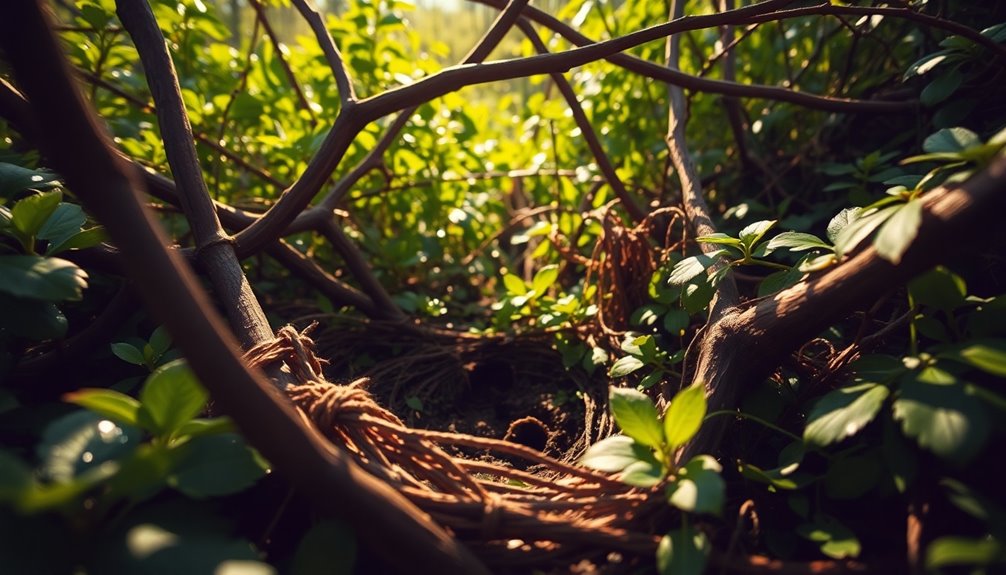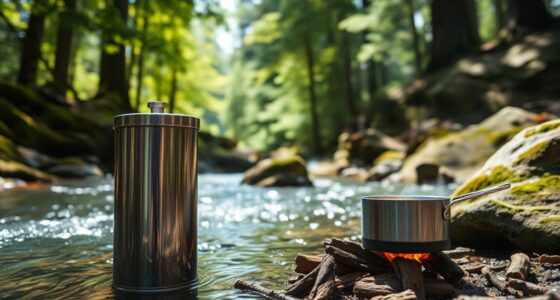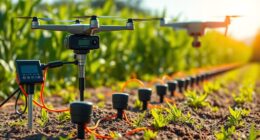Setting up life-saving traps in the wilderness is easier than you think. Start by mastering animal behavior; knowing where they travel boosts your chances of success. Use traps like spring snares or deadfalls in high-traffic areas and camouflage them with leaves to avoid detection. Don't forget to select the right bait that mimics their natural diet and position it near trails. Regularly check your traps for damage and adjust them as needed. These tips will help you catch food and stay nourished in emergencies. Stick around, and you'll uncover even more insights to enhance your trapping skills.
Key Takeaways
- Master animal behavior to effectively choose trap types and placement for increased success in wilderness trapping.
- Use natural materials to camouflage traps, ensuring they blend into the environment and avoid detection by wildlife.
- Position traps in high-traffic areas, like animal trails or near food sources, to maximize capture opportunities.
- Regularly check and maintain traps to ensure functionality, cleanliness, and ethical treatment of captured animals.
- Stay informed about local regulations and best practices to promote sustainable trapping and wildlife conservation.
Introduction
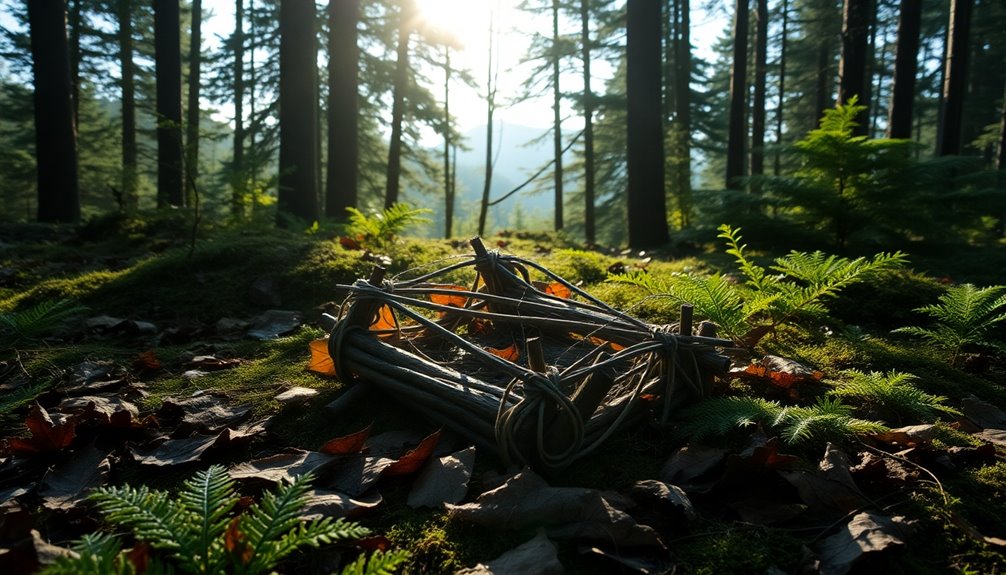
When you're in the wilderness, knowing how to set traps can mean the difference between survival and starvation.
Understanding essential trapping techniques not only helps you capture small game effectively but also increases your chances of finding food.
Let's explore the key methods that can enhance your survival skills through effective trapping.
Essential Trapping Techniques Overview
Trapping in the wilderness requires a deep understanding of animal behavior and the environment. To be effective, you need to master various trapping techniques, including spring snares, basic snares, and deadfall traps. Each type targets different game species and serves specific purposes, so knowing when to use each is essential.
Placing your traps along animal trails significantly increases your chances of capture. Regularly checking your traps not only promotes humane practices but also ensures they remain functional.
Camouflaging traps with natural materials like leaves and twigs can prevent detection by cautious animals, improving your success rate. Understanding the mechanics of deadfall triggers and the positioning of snares is vital for effective wilderness survival trapping.
Survival Through Effective Trapping
Mastering trapping techniques equips you with a vital skill set for wilderness survival. Effective trapping provides a reliable source of calories from meat and fat, freeing you to focus on other essential tasks while your traps act as automated hunters.
By learning various trap types like snares and deadfalls, you enhance your survival skills and adaptability in diverse environments. Understanding animal behavior and trail patterns is crucial for successful trap placement, increasing your chances of capturing food.
Regularly maintaining and checking your traps ensures humane practices, reducing animal distress and keeping your traps functional.
Lastly, familiarize yourself with local laws and ethical trapping practices to promote conservation and minimize harm to wildlife.
Trapping Techniques Defined
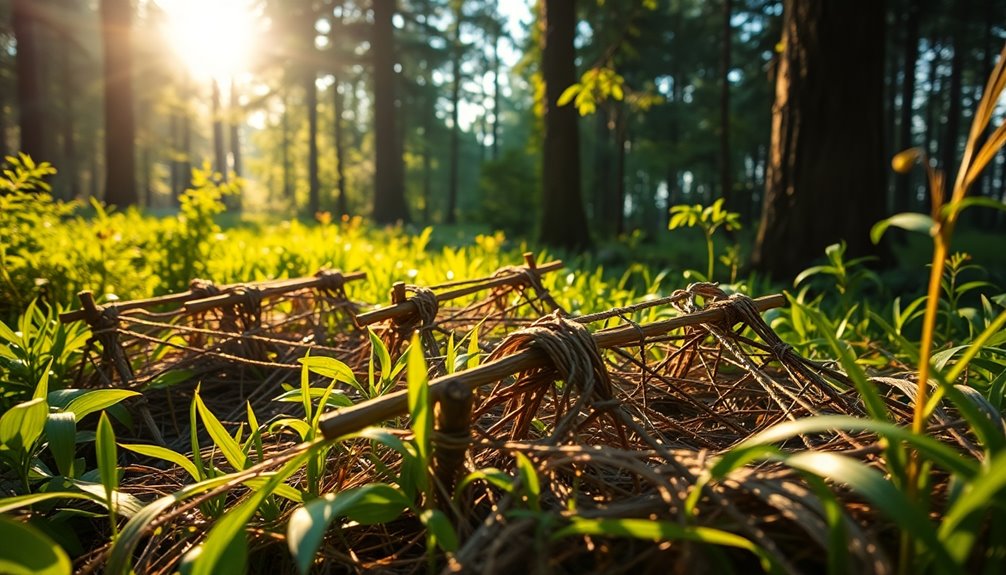
Understanding the intricacies of trapping techniques is crucial for anyone looking to successfully capture wildlife in the wilderness. You need to grasp animal behavior and patterns to strategically place traps in high-traffic areas.
Snares can be particularly effective when you adjust the noose size based on the target species, ensuring a secure catch. Additionally, camouflaging traps with natural materials like leaves and twigs helps conceal them, making it harder for animals to detect their presence.
Regular maintenance and inspection of your traps are essential to ensure they function properly and reduce any suffering for captured animals. By using a combination of trap types, such as snares and deadfalls, you can enhance your overall trapping success across various environments.
Food Security in Emergencies
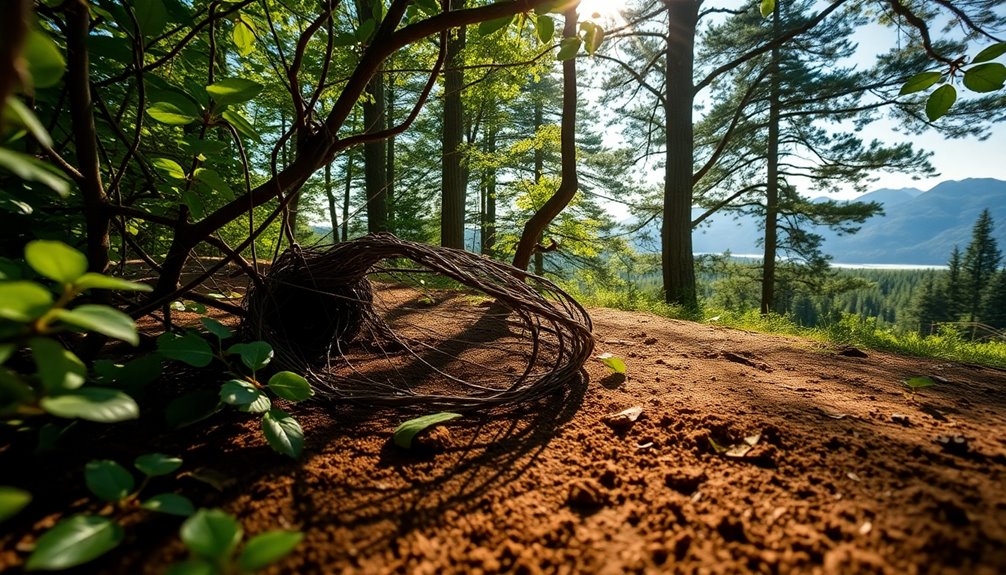
In wilderness emergencies, securing food is crucial for your survival.
By understanding wildlife behavior and using effective trapping techniques, you can set up reliable sources of protein.
This knowledge not only enhances your chances of survival but also allows you to focus on other essential tasks while ensuring a steady food supply.
Essential for Survival Skills
Trapping techniques are vital for survival skills, especially when it comes to securing food in emergencies. Mastering various survival traps, like snares and deadfalls, significantly enhances your food security by providing a reliable source of protein and fat.
These traps act as automated hunters, freeing you to focus on other essential survival tasks while ensuring a steady calorie intake from captured game. Understanding animal behavior and their travel patterns is crucial for effective trap placement; this knowledge increases your chances of successful captures.
Regularly checking your traps not only ensures humane treatment of any caught animals but also allows for timely harvesting of food resources. By incorporating a mix of trap types, you diversify your food sources and boost overall trapping success.
Wildlife Behavior Understanding
When you're in a survival situation, grasping wildlife behavior is key to securing food. Understanding feeding habits helps you place traps where animals are likely to pass.
For instance, make sure to observe that rabbits graze in open areas while raccoons prefer spots near water. Seasonal changes also affect foraging; animals become more aggressive in the fall, creating better trapping chances.
To attract your target species, know the right bait—fresh fruits for squirrels or carrion for raccoons work best. Look for signs like tracks and droppings to pinpoint active locations.
Even using one stick to prop up a trap can enhance your success rate. By observing these behaviors, you increase your chances of securing food in emergencies.
Effective Bait Selection Strategies
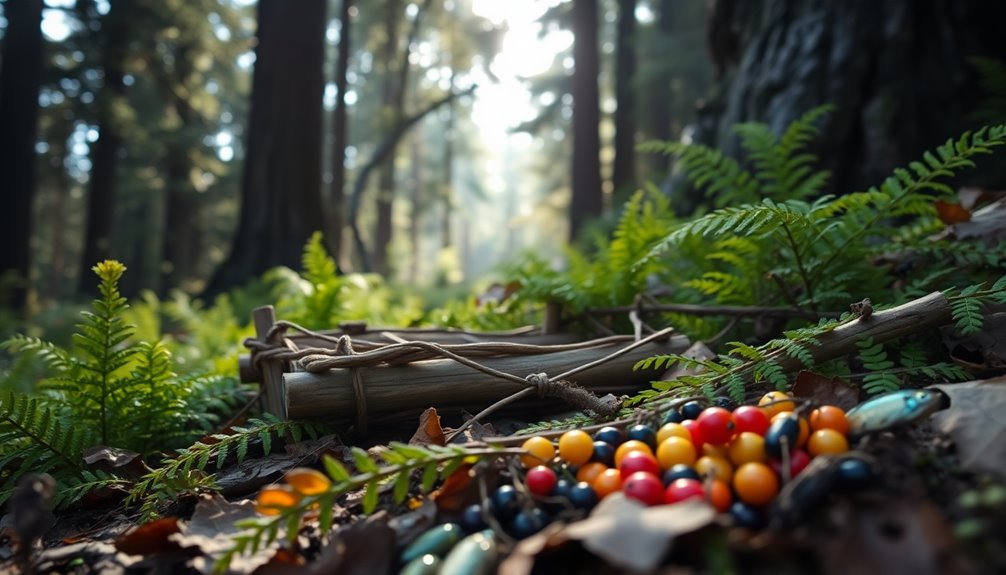
Successful bait selection strategies often make the difference between a fruitful trapping experience and a failed one. To increase your chances, choose bait that mimics the natural diet of your target species. For instance, use nuts for squirrels or meat scraps for carnivores.
Freshness is key; recently sourced bait boasts a stronger scent that attracts passing animals. Don't hesitate to experiment with different bait types like fruits, vegetables, or commercial scents to find what works best in your area.
Position your bait strategically, near animal trails or burrows, to draw them into the trap. Lastly, remember to change bait regularly to prevent spoilage and keep animals interested, ensuring your trapping efforts remain effective over time.
Essential Gear for Trapping
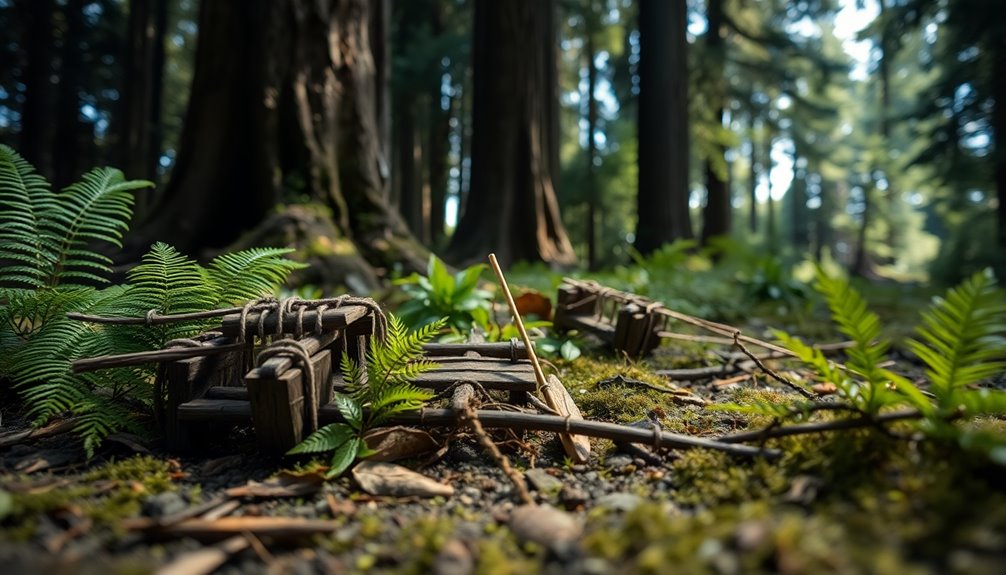
Having the right gear is crucial for a successful trapping experience in the wilderness. Start with sturdy cordage, like paracord or shoelaces, which you'll need for creating snares and securing traps.
A reliable cutting tool, such as a knife or multitool, is essential for crafting traps and preparing materials. Don't forget camouflage materials—using leaves and natural debris helps conceal your traps, increasing your chances of catching wary animals.
A small container for bait is also helpful; it allows you to store and transport food items that attract specific wildlife.
Lastly, always carry a first aid kit to address any injuries you might sustain while setting or checking your traps. Being prepared makes all the difference in the wild. Additionally, understanding Leave No Trace principles is important to minimize your environmental impact while trapping.
Trap Maintenance and Inspection
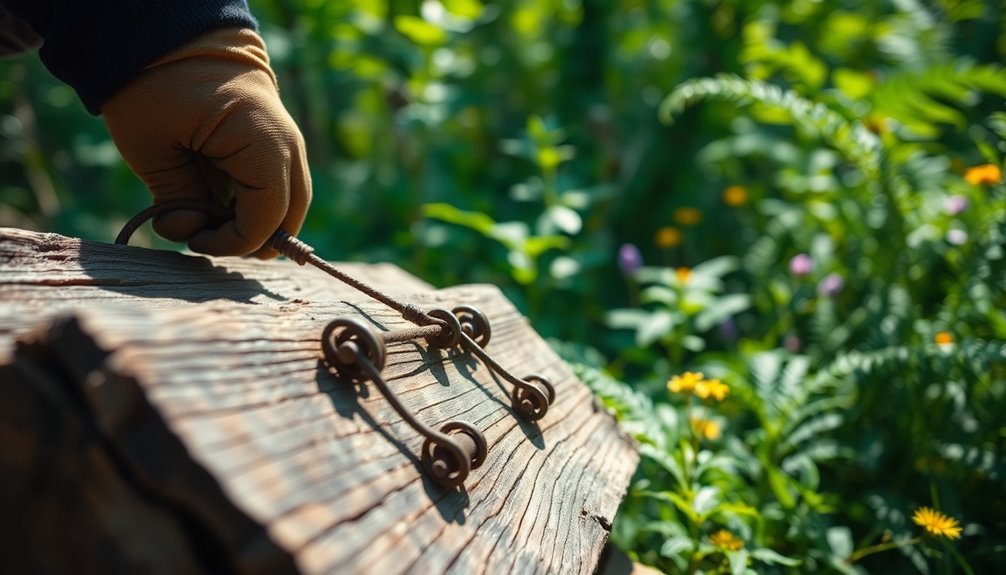
Maintaining and inspecting your traps is just as important as setting them up properly. Regularly check your traps for wear and damage to ensure they function correctly and effectively capture the animals you intend to catch.
After each use, clean your traps to remove any scents or debris that could deter animals from engaging with them. Store your traps in a dry, rust-free environment to prevent deterioration and maintain their longevity.
If you notice any broken components, replace them immediately to avoid malfunction during future trapping efforts. Additionally, practice your trap-setting skills regularly to stay proficient and ensure effective deployment in survival situations.
Consistent maintenance means your traps will be reliable when you need them most.
Trap Malfunction Troubleshooting Tips
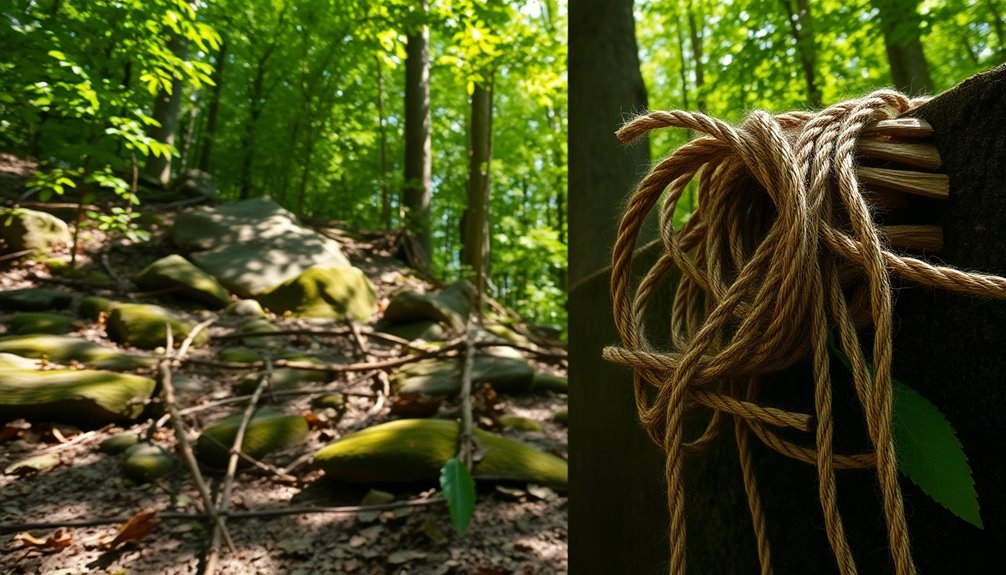
When setting your traps, placement is crucial to avoid malfunctions.
You need to optimize their location based on the surrounding environment to ensure they function effectively.
Trap Placement Techniques
To increase your chances of a successful catch, it's essential to place traps strategically in high-traffic areas like animal trails or near burrows.
Regularly inspect your traps for signs of wear or malfunction, such as broken components or misalignment, to ensure they operate effectively.
Adjust the sensitivity of triggers on deadfall traps to match the size and weight of your target animal; improper calibration can lead to missed captures.
Additionally, use camouflage materials like leaves and twigs around your traps to help them blend into the environment, preventing animals from detecting them.
If you haven't caught anything after a while, consider relocating your trap to a more promising area based on observed animal activity patterns.
Trap Placement Optimization Techniques
Optimizing trap placement is crucial for maximizing your success in the wilderness. Start by positioning your traps in high-traffic areas, like animal trails or near food sources, to boost capture rates and reduce malfunctions.
Regularly inspect and adjust your traps to adapt to environmental changes or shifts in animal behavior. Camouflage your traps with natural materials to prevent animals from detecting them, which can lead to cautious behavior and malfunctions.
Ensure the snare line's tension and positioning are correct; misalignment can result in ineffective traps. Lastly, scout and track local wildlife patterns to refine your placement strategy, helping you anticipate and mitigate unexpected behaviors that could disrupt your trapping efforts.
Survival Stories From Wilderness Experts

Many wilderness experts share captivating survival stories that highlight the critical role of traps in their experiences.
You'll find that well-placed snares often provided essential food sources during long expeditions. Many experts emphasize understanding animal behavior, noting that successful trapping hinges on knowledge of local wildlife trails and habits.
A common theme is the need for regular trap checks, showcasing a commitment to humane treatment of captured animals. Some professionals reveal that mastering trap types like the Figure 4 Deadfall and Basic Snare significantly boosts your chances of securing food in harsh conditions.
Additionally, expert narratives frequently highlight resourcefulness, using natural materials like sticks and stones for trap construction, proving that creativity can lead to effective survival strategies.
Conclusion

Trapping is a skill that can make a significant difference in wilderness survival, as highlighted by the stories shared by experts.
Mastering various trap types, like snares and deadfalls, can provide essential protein and fat during food shortages. Understanding animal behavior and habitat patterns boosts your success rate, allowing for strategic trap placement along trails and feeding areas.
Remember to check your traps regularly—not just for ethical reasons, but to ensure they remain effective. Using natural materials for traps enhances camouflage, reducing detection by wary animals.
Lastly, always adhere to local trapping regulations and ethical practices to maintain sustainable wildlife populations and avoid legal issues.
Additional Resources
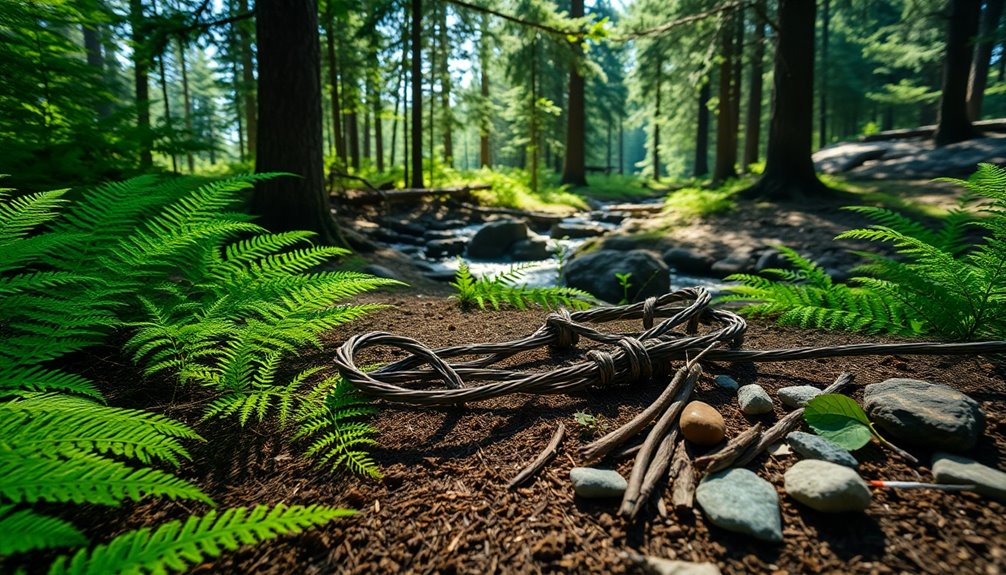
To enhance your trapping skills, exploring various resources can be invaluable. Start by checking out online tutorials and videos that visually demonstrate trap setups, especially complex designs like the Paiute Deadfall and Figure 4 Deadfall.
Don't forget to grab a copy of survival manuals like "The Trapper's Bible," which offer detailed instructions, tips, and illustrations for different traps.
Joining online forums or local survival groups can connect you with experienced trappers who share insights and troubleshooting advice.
Additionally, utilize wildlife identification resources to understand animal behavior and trails, improving your trap placement. Understanding animal behavior can significantly increase your trapping success rate.
Lastly, make sure to access local wildlife regulations and trapping permit information through government websites to stay compliant with legal and ethical practices.
Frequently Asked Questions
Why Are Primitive Traps Illegal in the US?
Primitive traps are illegal in the US mainly due to concerns about inhumane animal treatment. Many states have laws that prohibit certain trap types because they can cause prolonged suffering.
Additionally, unrestricted trapping threatens wildlife conservation by risking overharvesting and endangerment of species.
If you're considering trapping, make sure you understand and follow local regulations to avoid fines or legal issues that could arise from non-compliance.
What Are the 4 Main Types of Traps Used in Animal Trapping?
The four main types of traps used in animal trapping are spring snares, basic snares, deadfall traps, and box traps.
Spring snares activate with a trigger mechanism, capturing animals with minimal effort.
Basic snares are simple, using just a stick and cordage, perfect for small game.
Deadfall traps employ gravity to immobilize animals, while box traps bait creatures inside, ensuring a humane capture.
Each type serves a specific purpose, depending on the game and environment.
What Is a Rule of Etiquette for Setting Traps and Running Traplines?
When setting traps and running traplines, one key rule of etiquette is to prioritize safety.
Always place traps away from areas with high human or pet traffic to prevent accidents. Regularly check your traps, ideally every 24 hours, to minimize animal distress and ensure humane practices.
Additionally, familiarize yourself with local regulations and obtain necessary permits, which shows respect for wildlife conservation and promotes responsible trapping behavior in your community.
What Are the Safe Traps for Wild Animals?
When considering safe traps for wild animals, you might want to look into humane options like the Box Trap, which captures small animals without causing harm.
The Fixed Snare is another effective choice for catching rabbits and squirrels, as long as it's placed strategically.
Treadle Snares minimize injury by triggering only when an animal steps on a stick.
Just remember to check your traps regularly and follow local wildlife regulations to ensure ethical practices.

